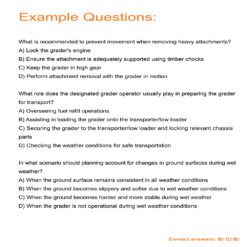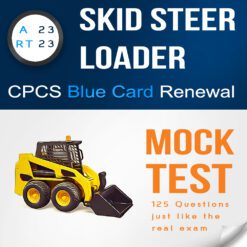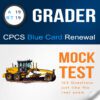RT19 CPCS Blue Card Renewal Mock Test with 123 Questions and Answers / A19 Grader
£15.00 Original price was: £15.00.£9.95Current price is: £9.95.
Conquer the Grader CPCS Blue Card Renewal Test: Realistic Practice Questions for Success!
- Questions & Answers: based on the latest RT 19 Grader – CPCS Renewal Test Revision FACTSHEET
- Categories: A 19 – Grader
- Number of Multiple-choice Questions: 123
- Format: PDF
- Delivery time: Instant download after checkout
- Refunds: No refunds once downloaded, unless you ordered duplicates by mistake.
If there are any issues with your download, please email CardRenewalTest@gmail.com and we’ll send it ASAP
Master Your CPCS Blue Card Renewal: RT19 Grader Mock Practice Test
Ace Your CPCS Blue Card Renewal with Confidence
Are you a dedicated Grader operator whose CPCS blue card is up for renewal? Don’t let the renewal test become a stumbling block in extending your competency certification for another five years. We understand the challenges of preparing for the CPCS RT19 Grader renewal test and how crucial it is to refresh your knowledge. That’s why we’ve developed a comprehensive and effective mock practice test tailored to help you pass the renewal test hassle-free.
The Challenge of CPCS Blue Card Renewal
Facing the CPCS Blue Card renewal test can be daunting. The RT19 Grader renewal assessment requires an understanding of various safety protocols, operational techniques, and compliance with industry regulations. Many experienced operators find the test challenging due to the extensive information needed to refresh their skills.
Introducing Your Solution: RT19 Grader CPCS Blue Card Renewal Mock Practice Test
Our RT19 Grader CPCS Blue Card Renewal Mock Practice Test is meticulously crafted to mimic the actual test, providing a structured and focused approach to your preparation. With 123 multiple-choice questions extracted from the latest NOCN CPCS RT19 Grader factsheet, this resource is designed to align with the real theory test format, helping you familiarize yourself with the kind of questions that will be asked.
Benefits of Using Our Mock Practice Test
- Comprehensive Preparation: Covering a wide range of topics related to Grader operations, safety measures, attachments, and more, this mock test ensures you’re thoroughly prepared.
- Realistic Test Simulation: Experience a test environment similar to the actual CPCS Blue Card renewal test, allowing you to assess your knowledge and readiness.
- Focused Learning: Simplify your study process by focusing on practical questions and answers, helping you understand key concepts and critical information from the RT19 Grader factsheet.
- Convenient and Time-Saving: Save time by practicing with these multiple-choice questions instead of reading lengthy chunks of text from the factsheet. It’s an efficient way to study for the test.
How to Pass the CPCS Blue Card Renewal Test
- Study Strategically: Use our RT19 Grader CPCS Blue Card Renewal Mock Practice Test to familiarize yourself with the type of questions you’ll encounter during the real test.
- Review the NOCN CPCS RT19 Grader Factsheet: While the mock test provides a streamlined review, going back to the original factsheet is crucial for a deeper understanding of the subject matter.
- Practice Consistently: Dedicate regular time to answer the multiple-choice questions, review answers, and understand the rationale behind each response.
- Seek Additional Resources: If needed, consider other study materials to supplement your preparation and enhance your understanding of Grader operations.
Conclusion
Renewing your CPCS Blue Card doesn’t have to be a stressful experience. With our RT19 Grader CPCS Blue Card Renewal Mock Practice Test, you can confidently approach the actual test, equipped with the knowledge and practice you need to succeed.
Here I’ve summarized the main learning points from the official RT19 Grader factsheet:
Preparation for Work (Preparation)
- Graders in Construction: Specialized machines used for grading, levelling, and formation work in various sectors like construction and quarrying.
- Infrequent Issues: Compared to other plant machinery, graders face infrequent problems.
- Operator Awareness: Grader operators need to be mindful of limited visibility, inefficiency, and working collaboratively.
- Pre-Use Checks: Regular checks are vital for maintaining performance and preventing component failures.
- Expert Advice: Seek guidance even for seemingly minor faults, as they could worsen or have hidden significance.
- Visibility Concerns: Regular cab glass cleaning and planned accessibility to challenging areas are crucial to avoid falls and improve visibility.
- At-Height Checks: Some pre-use checks might require height-related inspections; proper access equipment is necessary to avoid slips or falls.
- Attachment Fitting: Careful fitting and removal of heavy attachments such as dozer blades are crucial to prevent movement.
- Attachment Limitations: Understanding attachment limitations, especially when using scarifiers in hard ground, is essential.
- Dozer Blade Use: It’s used for light dozing activities, not for heavy material or at deep depths.
- Machine Transport: Correct preparation for transporting graders, ensuring frames are locked to prevent movement.
Working Safely and Efficiently (Working Safely)
- Route Planning: Pedestrian segregation, surface changes in wet weather, and keeping away from power lines are essential in travel and work planning.
- Whole Body Vibration: Considerations for minimizing vibration and harsh movements to the operator during long working hours.
- Seat Adjustment: Proper seat adjustment is crucial to avoid jolts transmitted directly to the operator.
- Roll-Over Protection: The presence of a roll-over protective structure (ROPS) minimizes injury risk in case of rollovers.
- Engine Shutdown: Best practice involves turning off the engine when leaving the cab to prevent accidental movement.
- Operating on Inclines: Understanding manufacturer stipulations for safe incline working to prevent instability and overturning.
- Descending Inclines: Caution is advised to prevent engine over-speed due to machine momentum.
- Efficient Operation: Understanding blade angles, circle positions, and axle articulation for efficient work.
- Optimum Angles: Configuring the blade at a 45-degree angle for removing corrugations.
- Equipment Maintenance: Using appropriate techniques, such as ripper or scarifier, for maintaining haul roads.
Stability and Visibility (Stability)
- Reversing Dangers: Workplace incidents are often associated with vehicle and plant reversing; steps should be taken to eliminate reversing or minimize it in segregated areas.
- Vision Aids: Limitations in vision aids like mirrors and CCTV systems should be considered despite providing assistance.
- Operating Techniques: Different operating techniques required when working across slopes, avoiding excessive down pressure on the blade to prevent instability.
- Weight Displacement: Moving the grader in specific positions can cause instability due to the weight distribution.
- Edge Proximity Risks: Working too close to an edge can lead to instability and safety hazards.
These learning points cover a broad spectrum of topics related to grader operation, safety, and efficient work practices outlined in the RT19 Grader factsheet.
Be the first to review “RT19 CPCS Blue Card Renewal Mock Test with 123 Questions and Answers / A19 Grader” Cancel reply
Related products
CPCS Blue Card Renewal Tests
RT22 CPCS Blue Card Renewal Mock Test with 144 Questions and Answers / A22 Tracked Loading Shovel
CPCS Blue Card Renewal Tests
RT42 CPCS Blue Card Renewal Mock Test with 117 Questions and Answers / A42 Crusher
CPCS Blue Card Renewal Tests
RT60 CPCS Blue Card Renewal Mock Test with 151 Questions and Answers / A60 Mobile Crane
CPCS Blue Card Renewal Tests
RT39 CPCS Blue Card Renewal Mock Test with 140 Questions and Answers / A39 Skip Handler
CPCS Blue Card Renewal Tests
RT12 CPCS Blue Card Renewal Mock Test with 130 Questions and Answers / A10, A12 Excavator 180°
CPCS Blue Card Renewal Tests
CPCS Blue Card Renewal Tests
RT23 CPCS Blue Card Renewal Mock Test with 125 Questions and Answers / A23 Skid Steer Loader
CPCS Blue Card Renewal Tests
RT24 CPCS Blue Card Renewal Mock Test with 128 Questions and Answers / A24 Motorised Scraper

















Reviews
There are no reviews yet.